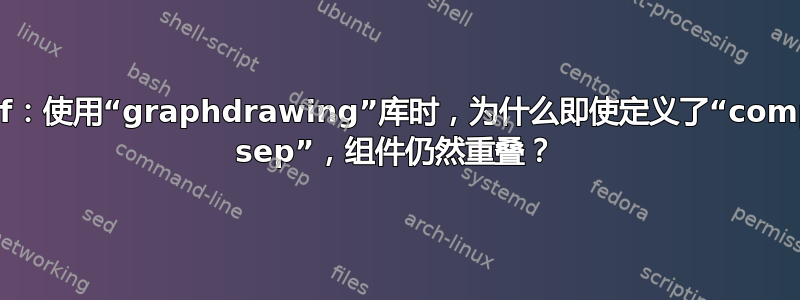
来源:
\documentclass{standalone}
\usepackage{fixltx2e}
\usepackage{amsmath}
\def\SP#1{\textsuperscript{#1}}
\def\SB#1{\textsubscript{#1}}
\def\SPSB#1#2{\rlap{\textsuperscript{#1}\textsubscript{#2}}}
%======================================
\usepackage{tikz}
\usetikzlibrary{graphdrawing}
\usetikzlibrary{arrows}
\usetikzlibrary{graphs}
\usetikzlibrary{decorations.pathmorphing}
\usegdlibrary{force, layered, trees, ogdf}
%======================================
\begin{document}
\tikz
\graph [spring layout, node distance = 20mm, nodes = draw, component sep = 5mm, component packing = rectangular]
{
RacOn/"\textbf{Rac\SB{on}}";
kRacOnToOffM/"${k^{{Rac}}_{{on}\rightarrow{off}}}$";
kRacOffMtoOn/"${k^{{Rac}}_{{on}\leftarrow{off}}}$";
Rac [draw, circle] // [spring layout, node distance = 10mm, component sep = 5mm, component packing = rectangular]
{
RacOn ->[very thick, bend right, orient = 90]
kRacOffMtoOn ->[decorate, decoration=snake, blue, orient = 90]
RacOn ->[decorate, decoration=snake, red, orient = 90]
kRacOnToOffM
};
RhoOn/"\textbf{Rho\SB{on}}";
kRhoOnToOffM/"${k^{{Rho}}_{{on}\rightarrow{off}}}$";
kRhoOffMtoOn/"${k^{{Rho}}_{{on}\leftarrow{off}}}$";
Rho [draw, circle] // [spring layout, node distance = 10mm, component sep = 5mm, component packing = rectangular]
{
kRhoOffMtoOn ->[decorate, decoration=snake, blue]
RhoOn ->[decorate, decoration=snake, red]
kRhoOnToOffM
};
chemoattractant/"chemoattractant";
%chemoattractant -!- Rac;
%chemoattractant -!- Rho;
chemorepellant/"chemorepellant";
%chemorepellant -!- Rac;
%chemorepellant -!- Rho;
memProtrusion/"membrane protrusion";
%memProtrusion -!- Rac;
%memProtrusion -!- Rho;
memRetraction/"membrane retraction";
%memRetraction -!- Rac;
%memRetraction -!- Rho;
memTension/"membrane tension";
%memTension -!- Rac;
%memTension -!- Rac;
contact/"intercellular contact";
%contact -!- Rac;
%contact -!- Rho;
chemoattractant ->[very thick] kRacOffMtoOn;
chemorepellant ->[very thick] kRhoOffMtoOn;
RacOn ->[very thick, bend right] memProtrusion ->[very thick] memTension ->[very thick] kRacOnToOffM;
RhoOn ->[very thick] memRetraction ->[>=|, very thick] memTension;
contact ->[very thick, bend right] kRhoOffMtoOn;
};
\end{document}
输出:

问题:
我打开了所有节点的边框绘制,如上所示,您可以看到,即使在我指定了键之后,它们中的很多仍然重叠component sep。
我猜测正在发生的事情是,由于某种原因,在进行这些计算时没有考虑每个节点的“文本”。
为了实现适当的分离我应该怎么做?
答案1
这是另一个建议layered layout
\documentclass[tikz,margin=5mm]{standalone}
\usepackage{fixltx2e}
\usepackage{amsmath}
\def\SP#1{\textsuperscript{#1}}
\def\SB#1{\textsubscript{#1}}
\def\SPSB#1#2{\rlap{\textsuperscript{#1}\textsubscript{#2}}}
\usepackage{tikz}
\usetikzlibrary{graphs,graphdrawing,arrows}
\usetikzlibrary{decorations.pathmorphing}
\usegdlibrary{force, layered, trees}
\begin{document}
\tikz\graph [layered layout, nodes=draw]
{
RacOn/"\textbf{Rac\SB{on}}";
kRacOnToOffM/"${k^{{Rac}}_{{on}\rightarrow{off}}}$";
kRacOffMtoOn/"${k^{{Rac}}_{{on}\leftarrow{off}}}$";
%
Rac [draw, circle]//[spring layout]
{
RacOn ->[very thick, bend right, orient = 90]
kRacOffMtoOn ->[decorate, decoration=snake, blue, orient = 90]
RacOn ->[decorate, decoration=snake, red, orient = 90]
kRacOnToOffM
};
%
RhoOn/"\textbf{Rho\SB{on}}";
kRhoOnToOffM/"${k^{{Rho}}_{{on}\rightarrow{off}}}$";
kRhoOffMtoOn/"${k^{{Rho}}_{{on}\leftarrow{off}}}$";
%
Rho [draw, circle]//[spring layout]
{
kRhoOffMtoOn ->[decorate, decoration=snake, blue]
RhoOn ->[decorate, decoration=snake, red]
kRhoOnToOffM
};
%
chemorepellant ->[very thick,bend right=30] kRhoOffMtoOn;
chemoattractant ->[very thick] kRacOffMtoOn;
contact ->[very thick, bend right] kRhoOffMtoOn;
RhoOn ->[very thick,bend right=70] memRetraction/"membrane retraction"
->[>=|, very thick, bend right=10] memTension/"membrane tension";
RacOn ->[very thick, bend right=90] memProtrusion/"membrane protrusion"
->[very thick] memTension ->[very thick,bend right=65] kRacOnToOffM;
};
\end{document}

答案2
增加作品的价值node distance:
\documentclass{standalone}
\usepackage{fixltx2e}
\usepackage{amsmath}
\def\SP#1{\textsuperscript{#1}}
\def\SB#1{\textsubscript{#1}}
\def\SPSB#1#2{\rlap{\textsuperscript{#1}\textsubscript{#2}}}
%======================================
\usepackage{tikz}
\usetikzlibrary{graphdrawing}
\usetikzlibrary{arrows}
\usetikzlibrary{graphs}
\usetikzlibrary{decorations.pathmorphing}
\usegdlibrary{force, layered, trees}
%======================================
\begin{document}
\tikz
\graph [spring layout, node distance= 5.5cm, nodes = draw, component sep = 50mm, component packing = rectangular]
{
RacOn/"\textbf{Rac\SB{on}}";
kRacOnToOffM/"${k^{{Rac}}_{{on}\rightarrow{off}}}$";
kRacOffMtoOn/"${k^{{Rac}}_{{on}\leftarrow{off}}}$";
Rac [draw, circle] // [spring layout, node distance = 10mm, component sep = 5mm, component packing = rectangular]
{
RacOn ->[very thick, bend right, orient = 90]
kRacOffMtoOn ->[decorate, decoration=snake, blue, orient = 90]
RacOn ->[decorate, decoration=snake, red, orient = 90]
kRacOnToOffM
};
RhoOn/"\textbf{Rho\SB{on}}";
kRhoOnToOffM/"${k^{{Rho}}_{{on}\rightarrow{off}}}$";
kRhoOffMtoOn/"${k^{{Rho}}_{{on}\leftarrow{off}}}$";
Rho [draw, circle] // [spring layout, node distance = 10mm, component sep = 5mm, component packing = rectangular]
{
kRhoOffMtoOn ->[decorate, decoration=snake, blue]
RhoOn ->[decorate, decoration=snake, red]
kRhoOnToOffM
};
chemoattractant/"chemoattractant";
%chemoattractant -!- Rac;
%chemoattractant -!- Rho;
chemorepellant/"chemorepellant";
%chemorepellant -!- Rac;
%chemorepellant -!- Rho;
memProtrusion/"membrane protrusion";
%memProtrusion -!- Rac;
%memProtrusion -!- Rho;
memRetraction/"membrane retraction";
%memRetraction -!- Rac;
%memRetraction -!- Rho;
memTension/"membrane tension";
%memTension -!- Rac;
%memTension -!- Rac;
contact/"intercellular contact";
%contact -!- Rac;
%contact -!- Rho;
chemoattractant ->[very thick] kRacOffMtoOn;
chemorepellant ->[very thick] kRhoOffMtoOn;
RacOn ->[very thick, bend right] memProtrusion ->[very thick] memTension ->[very thick] kRacOnToOffM;
RhoOn ->[very thick] memRetraction ->[>=|, very thick] memTension;
contact ->[very thick, bend right] kRhoOffMtoOn;
};
\end{document}

node distance在图书馆的情况下有一个特殊的行为graphdrawing,如第节所述27.3 填充和节点距离PGF 手册:
这是由一条边连接的节点中心应具有的最小距离。并不总是能够满足这个期望距离,例如当节点太大时。在这种情况下,长度仅被视为下限。
因此,如果节点太大(如您相对于最初指定的值的情况一样),则距离将被视为下限。
node distance对于这个库来说,它似乎有点奇怪(至少对我来说)graphdrawing;例如,有些布局会默默地忽略这个选项。


